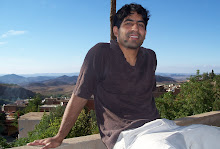
I would say that the Balti proverb illustrated in the Gregg Mortenson book "Three Cups of Tea" runs true in some parts of Morocco
I have asked some Moroccan families to explain this custom to me and some have said that it has to do with protection from strangers and some of the women have said that they would rather leave the men alone to speak about whatever they feel like and would prefer to congregate with other women. I would add that in all instances the food has been fantastic, which has served to minimize my concern about the absence of women at the dinner table during the course of the meal, but then the guilty feelings resurface when the food settles.
"It's not you; it's me"
Before I make any blanket statements about other cultures, I like to do a little introspection. Perhaps, it's not them, but who I am that is prompting them to behave in that particular way. Maybe, it's not that I am a man, but rather a very strange man. Luckily, not too long ago, Joy and I received a dinner invitation from a female friend Joy had met at Amina's coop boutique on one of her first visits to the shamal(north). I was really curious about this dinner. Would Joy be asked to eat with the women and I with the men? Would everyone dine together since it wasn't just this strange man as the guest, but also a very amicable and not Moroccan-looking Peace Corps volunteer? (On one occasion I visited a family who upon entering the home said to their son, "But, I thought you said he was American?")
We arrived and were seated in their large dining salon. It was a splendid salon with beautifully tiled walls, large Persian-style carpets on the floor, and Andalusian-styled, artisan designed furniture. We both greeted the entire family. For Joy, it was her second or third time there so she gave lots of hugs and kisses to all the women and kids. Since this was a large crowd, my greeting is the customary handshake that I equate to a quick down-low high-five slap of the hands that is then proceeded by a left chest slap to one's heart that I now reciprocate without even thinking. Some folks kiss the hand that was slapped, but I have yet to incorporate that in my greetings for personal OCD reasons.
When we were seated in the large dining room, Joy and I were in the company of all the men in the house, which included the father, brothers, and close cousins, with the exception of Joy's friend who would join the conversation from time to time. We spoke about a number of issues even the taboo subjects of politics were discussed. Her friend then brought the dinner courses one after another, but did not dine with us. We pigged out in traditional Peace Corps volunteer fashion. (Generally, my goal for cooking is to make something edible and worth eating a second time as leftovers so the treat of a professionally cooked Moroccan meal is consumed to the maximum capacity available, which is often tested to its very limit on these rare occasions.) Joy and I ate and conversed with the men all night while all the ladies ate in separate yet equal in size dining room with all the kids and the television.
I was somewhat relieved that the hosts treated Joy and me equally and it wasn't just me or my strange ways altering their routine. I will continue to ponder this. I gotta say though that I’m not really fond of having to eat with just the men. Don’t get me wrong. The conversations are great, but I still feel like I'm more of nuisance than an honored guest. Well, there is only one way to solve the ordeal. No, I’m not going to tell them how I feel about their “three meals gets you into the circle of trust” tradition. I am going to proceed graciously and gladly to my second and third meals.
























